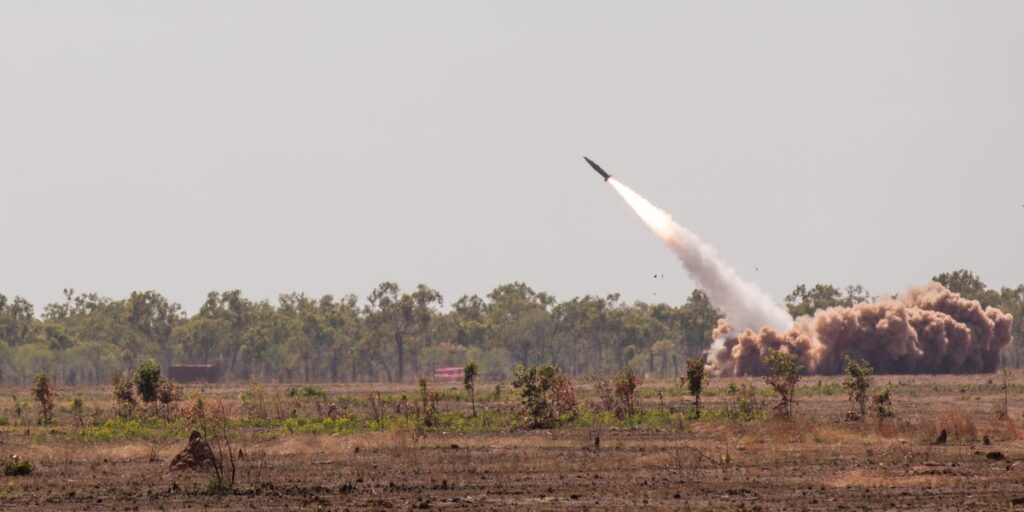The US and some of its NATO allies are pushing ahead with plans to develop and field new long-range strike options in Europe as the Ukraine war highlights the combat value of these weapons and a lack of restrictions in this space gives way to new movement.
The new moves reflect one of the most dangerous aspects of the Cold War, risking escalation and a deep-strike arms race with Russia, arms control experts say.
“We’ve been down this road before, and it took us many decades to get off it with hard-learned lessons about the dangers of” an intermediate-range “missile escalation in Europe,” Hans Kristensen, Director of the Nuclear Information Project at the Federation of American Scientists told Business Insider.
He called the potential “tit-for-tat escalation posturing” a hallmark of the Cold War that could make a comeback now.
The US announced plans last week to place long-range capabilities in Germany, beginning in 2026 with episodic deployments prior to permanent stationing at a future unforeseen date.
“When fully developed,” the allies wrote in a statement,” these conventional long-range fires units will include SM-6, Tomahawk, and developmental hypersonic weapons, which have significantly longer range than current land-based fires in Europe.”
That announcement was followed a day later by movement on plans from a handful of NATO allies to develop new long-range missiles. France, Poland, Germany, and Italy signed the initiative focusing on ground-launched cruise missiles with ranges in excess of 500 kilometers.
In both cases, the US and its European partners are responding to what they see as critical gaps in their long-range fires arsenals exposed by the war in Ukraine.
The war has “demonstrated something that many already knew: Long-range strike weapons are of great utility for fighting wars,” Fabian Hoffmann, a doctoral research fellow at the Oslo Nuclear Project at the University of Oslo, wrote in a War on the Rocks commentary.
“The ability to engage targets at operational and strategic depth critically enables the conduct of offensive and defensive maneuvers and can shape the conditions for victory on the battlefield,” he explained.
The new plans follow years of rising tension between the West and Russia on a range of issues, including long-range fires in the aftermath of the 2019 US withdrawal from the INF Treaty, which Washington accused Moscow of violating. Russia denied the allegations and later also pulled out of the agreement, opening the door for both to develop and field new ground-launched ballistic and cruise missiles.
In response to the US and Germany’s plans, as well as other NATO actions, Kremlin spokesperson Dmitry Peskov said: “This is a very serious threat to the national security of our country.”
“All of this,” he said, “will require us to take thoughtful, coordinated, effective responses to deter NATO, to counteract NATO.”
Experts pointed to Russia’s violation of the INF Treaty as prompting a snowball effect. “I have long said that Russians will come to regret Putin’s violation of the 1987 INF Treaty. He opened the door to significant deployments of accurate, long-range conventional missiles in Germany and elsewhere,” Jeffrey Lewis, a professor at the Middlebury Institute of International Studies at Monterey and a nuclear proliferation expert, wrote on X.
Though Russia set this in motion, the deployment plans for Europe certainly seem escalatory, Kristensen explained, and will likely prompt Russia to deploy more of its own long-range weapons.
“There is an element of autopilot in this dynamic because each side uses acts by the other to justify more and more steps to build up its military capabilities,” he said, adding that it seems the East and West are back on track for “tit-for-tat reactions.”
Kristensen’s views echoed concerns from other experts and officials on the latest developments.
Jon B. Wolfsthal, a nuclear arms control and nonproliferation expert and an Obama administration official for national security affairs, posted on X that “we have recreated one of the most dangerous components of the Cold War in Europe and things will only get worse from here.”
Conventional long-range strike capabilities within the 500-kilometer to 5,500-kilometer range provide a powerful ability to strike deep into enemy territory with little to no notice. Though the intention in fielding new capabilities may be deterrence, it could instead ignite an arms race.
The silver lining in the US agreement with Germany, Kristensen said, is that it’s non-nuclear.
But, he added, “conventional missiles — especially fast-flying ballistic missiles — have their own problems in that they shorten the time leaders have to react and therefore increases risk of overreaction and mistakes, factors that drive worst-case planning and undermines crisis stability. And superior conventional capabilities can drive the other side to rely more on nuclear weapons to compensate.”
Read the full article here
















